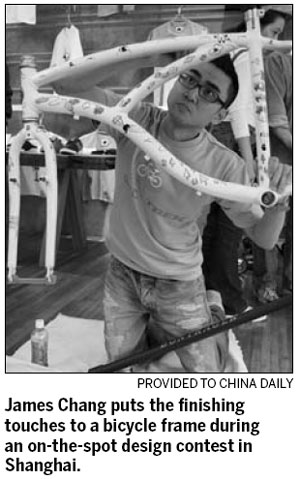一站式方案哪里得
伦敦艺术大学广州招生代表处 | 2012-03-22
Where to go for one-stop solutions
一站式方案哪里得
15年的设计经历,中国设计师 James Chang 尝试多多,游走于平面、室内、产品、多媒体等多个领域。跨界与建筑师、室内设计师、音乐家等合作,提供一站式方案,成为他的市场攻略,而且,驾轻就熟。怎样的人生经验和文化熏陶,会铸就今天的他,且看下文。
How many people does it take to create a website, design a T-shirt, plan a VIP lounge, make product packaging and put together a video installation? James Chang has shown that sometimes you need only one.

In his 15 years as a designer, Chang has taken on numerous jobs in different design fields. He has moved back and forth among interactive, graphic, interior, product and multimedia design. And there's no other place he'd rather be.
"It is how I like to market myself right now - as a one-stop-solution designer," says the 35-year-old creative director of TC Interactive, an e-commerce startup in
"I can work in all different disciplines, platforms - with architects, interior designers, musicians. You name it."
Chang left
He later started out creating multimedia products for a print design company in
When he returned to
"At the time, this industry was not really clearly defined," he says.
"Clients needed you to do different types of things in different areas of design. Of course, a lot of clients had no idea that different areas actually required different skills. They just figured that if you were a designer you could do all these things. So I had the opportunity to experiment."
The proficiency he developed across design disciplines transformed him into what practitioners call a "crossover designer".
Chang hails from a new generation of versatile designers shaped by advances in technology and connectivity, globalization and the complex social questions of our times. Industry insiders say more such professionals will be needed to work alongside specialist designers in the 21st century.
"Companies like designers who are experts in their field but also can work with other specialists to produce something that is more than a sum of its parts," Dani Salvadori, director of enterprise and innovation at London's Central Saint Martins College of Arts and Design, says in an e-mail.
"These people are described as 'T-shaped people', where the vertical stroke is their specialization and the horizontal stroke is the ability to work with others. The reason is that, in the current market, new products and services require expertise from more than one area."
Having witnessed these changes in the job and consumer markets, some of the world's most renowned design schools began creating courses and programs to train students to think across disciplines.
"Within the design field, the boundaries between disciplines have been crumbling in lots of ways over the last 15, 20 years,"
"We've completely redesigned the curriculum of Parsons based on our own knowledge of the fact that designers will often have more than one or two or three and upwards of five career trajectories over the course of their lives as professional designers."
Chang has his own take on the matter.
"Many people are scared of doing this because they are afraid that they are not going to be good at anything, because they might spread themselves too thinly," he says.
"It takes a lot of courage, for sure."
(英文信息来自伦敦艺术大学)